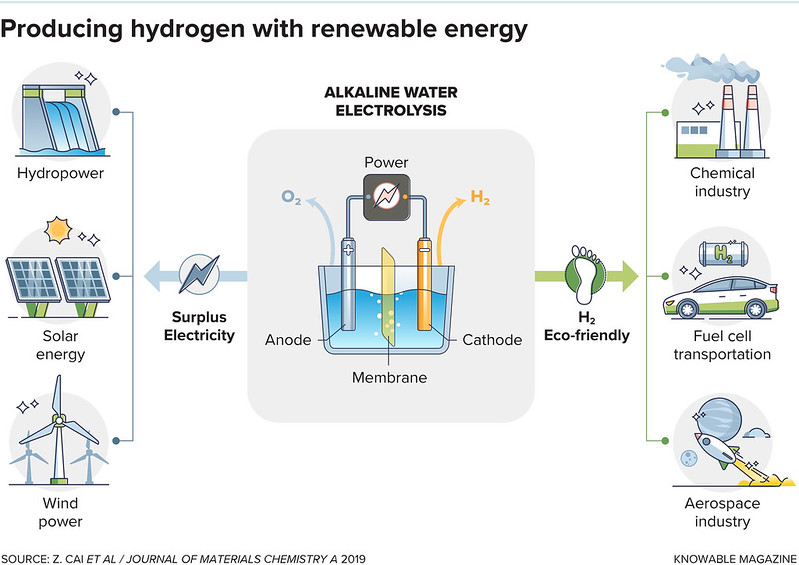How Energy is Stored in Hydrogen
Hydrogen is an effective energy carrier, capable of storing large amounts of energy in a compact form. This makes it a valuable resource for balancing the intermittency of renewable energy sources and for providing a clean energy solution across various sectors. Here’s a detailed look at how energy is stored in hydrogen:
1. Hydrogen Production
To store energy in hydrogen, we first need to produce hydrogen gas. This is primarily done through a process called electrolysis, which involves splitting water (H2O) into hydrogen (H2) and oxygen (O2) using an electric current. When the electricity used for electrolysis comes from renewable sources like solar or wind power, the hydrogen produced is known as green hydrogen. Here’s a simplified overview of the electrolysis process:
- Water Splitting: Electrolyzers use electricity to break down water molecules into hydrogen and oxygen.
- Energy Input: The energy from electricity is stored in the chemical bonds of the hydrogen molecules.
2. Hydrogen Storage Methods
Once produced, hydrogen can be stored in various forms. The main methods of hydrogen storage are:
a. Compressed Hydrogen
- Method: Hydrogen gas is compressed and stored in high-pressure tanks.
- Pressure: Typically, hydrogen is stored at pressures of 350-700 bar (5,000-10,000 psi).
- Applications: This method is commonly used in hydrogen fuel cell vehicles and for industrial applications.
b. Liquid Hydrogen
- Method: Hydrogen gas is cooled to cryogenic temperatures (-253°C or -423°F) to become a liquid.
- Density: Liquid hydrogen is denser than gaseous hydrogen, allowing more hydrogen to be stored in the same volume.
- Applications: Used in aerospace applications and some transportation applications.
c. Metal Hydrides
- Method: Hydrogen is absorbed and released by certain metal alloys.
- Safety: This method is relatively safe as it operates at lower pressures and temperatures compared to other methods.
- Applications: Suitable for portable applications and some stationary storage systems.
d. Chemical Storage
- Method: Hydrogen is stored in chemical compounds such as ammonia (NH3) or methanol (CH3OH).
- Conversion: The hydrogen can be released from these compounds through chemical reactions.
- Applications: Useful for long-distance transportation and for applications where high energy density is required.
3. Energy Conversion and Utilization
To use the stored energy, hydrogen must be converted back into electricity or heat. This can be done using fuel cells or by burning hydrogen in a combustion engine.
a. Fuel Cells
- Working Principle: Fuel cells convert the chemical energy of hydrogen directly into electricity through an electrochemical reaction with oxygen.
- Efficiency: Fuel cells are highly efficient and produce only water and heat as byproducts.
- Applications: Used in various applications including vehicles, stationary power generation, and portable power devices.
b. Combustion
- Method: Hydrogen can be burned in internal combustion engines or turbines to produce heat or electricity.
- Emissions: Burning hydrogen produces water vapor as the only emission, making it a clean alternative to fossil fuels.
- Applications: Used in power plants, industrial heating processes, and transportation.
4. Benefits of Hydrogen Energy Storage
- High Energy Density: Hydrogen has a high energy content per unit weight, making it a potent energy carrier.
- Scalability: Hydrogen storage can be scaled up or down depending on the energy needs, from small portable applications to large industrial uses.
- Renewable Integration: Hydrogen storage enables the effective use of intermittent renewable energy sources by storing excess energy and releasing it when needed.
- Clean Energy: When produced from renewable sources, hydrogen is a clean energy carrier with no carbon emissions.
5. Challenges and Future Prospects
While hydrogen energy storage offers many benefits, there are challenges to address:
- Cost: Producing, storing, and transporting hydrogen can be expensive. Ongoing research and development aim to reduce these costs.
- Infrastructure: Developing a robust infrastructure for hydrogen production, storage, and distribution is necessary for widespread adoption.
- Safety: Hydrogen is highly flammable, requiring strict safety measures for handling and storage.
Conclusion
Hydrogen is a versatile and powerful energy carrier, capable of storing and releasing large amounts of energy. By utilizing various storage methods and converting hydrogen back into electricity or heat, we can effectively harness and stabilize renewable energy sources. Despite current challenges, advancements in technology and infrastructure are paving the way for hydrogen to play a crucial role in a sustainable and clean energy future.
Combining Hydrogen with Renewable Energy

Renewable energy sources like solar, wind, and hydropower are crucial for a sustainable future. However, these sources are intermittent, meaning they don’t produce energy consistently. This is where hydrogen comes in. Hydrogen, as an energy carrier, can store and transport energy produced from renewable sources. This combination can play a significant role in the transition to a low-carbon economy. Here’s a closer look at how hydrogen and renewable energy can work together.
Understanding Hydrogen
Hydrogen is the most abundant element in the universe. It is a clean fuel that, when used in a fuel cell, produces only water and electricity. Hydrogen can be produced from various sources, but the most sustainable method is through the use of renewable energy. This process is called electrolysis.
Electrolysis and Renewable Energy
Electrolysis is the process of using electricity to split water into hydrogen and oxygen. When renewable energy sources like solar or wind generate electricity, this electricity can be used to power electrolyzers. Electrolyzers are devices that carry out the electrolysis process. By using renewable energy for electrolysis, we can produce “green hydrogen,” which is hydrogen generated with minimal environmental impact.
Benefits of Combining Hydrogen with Renewable Energy
- Energy Storage: One of the most significant benefits of combining hydrogen with renewable energy is energy storage. Renewable energy sources are intermittent. For example, solar power is only available during the day, and wind power depends on weather conditions. Hydrogen can store the excess energy produced during peak production times. This stored hydrogen can then be converted back into electricity when renewable energy generation is low.
- Grid Stability: Storing energy in the form of hydrogen helps stabilize the power grid. By converting excess renewable energy into hydrogen, we can prevent overloading the grid. During periods of high demand, this hydrogen can be used to generate electricity, ensuring a consistent energy supply.
- Decarbonizing Various Sectors: Hydrogen can be used in sectors that are hard to electrify. For instance, in heavy industries like steel and cement production, hydrogen can replace fossil fuels, significantly reducing carbon emissions. In transportation, hydrogen fuel cells can power vehicles, including cars, buses, and even ships and airplanes.
- Energy Independence: By producing hydrogen from locally available renewable resources, countries can reduce their dependence on imported fossil fuels. This enhances energy security and can lead to economic benefits by creating local jobs in the renewable energy and hydrogen production sectors.
- Reducing Greenhouse Gas Emissions: The use of green hydrogen helps in reducing greenhouse gas emissions. Hydrogen production from renewable sources does not emit carbon dioxide, making it a clean alternative to traditional fossil fuels.
Challenges and Solutions
While the combination of hydrogen and renewable energy has many benefits, there are challenges to overcome.
- Cost: Currently, producing green hydrogen is more expensive than producing hydrogen from fossil fuels. However, the cost of renewable energy is decreasing, and advancements in electrolyzer technology are expected to lower costs further. Governments and private sectors can also play a role by investing in research and providing subsidies to make green hydrogen more competitive.
- Infrastructure: The infrastructure for hydrogen production, storage, and distribution is still underdeveloped. Building a robust hydrogen infrastructure requires significant investment. Governments can facilitate this by developing policies and regulations that support hydrogen infrastructure development.
- Efficiency: The process of converting renewable energy to hydrogen and then back to electricity can be less efficient compared to direct use of renewable energy. Improving the efficiency of electrolyzers and fuel cells is an ongoing area of research.
- Safety: Hydrogen is highly flammable, and there are concerns about its storage and transport. However, with proper safety measures and regulations, these risks can be managed effectively. Advances in technology are also making hydrogen storage and transport safer.
Real-World Applications
Several projects around the world are already demonstrating the potential of combining hydrogen with renewable energy.
- Hydrogen Valleys: These are regions where hydrogen is produced, stored, and used locally. In Europe, several hydrogen valleys are being developed, integrating renewable energy with hydrogen production to create sustainable energy ecosystems.
- Transportation: Countries like Japan and South Korea are investing heavily in hydrogen-powered vehicles. Hydrogen fuel cell buses, trucks, and trains are being tested and deployed in various parts of the world.
- Industry: Companies in the steel and chemical industries are beginning to use green hydrogen to reduce their carbon footprint. For example, some steel plants are experimenting with hydrogen to replace coal in the steelmaking process.
- Power to Gas: This concept involves converting excess renewable electricity into hydrogen, which can then be injected into the natural gas grid. This not only helps store excess renewable energy but also reduces the carbon content of natural gas.
The Future of Hydrogen and Renewable Energy
The future of hydrogen and renewable energy is promising. As the world moves towards decarbonization, the role of hydrogen will become increasingly important. Continuous technological advancements, supportive policies, and international cooperation will be key to overcoming the challenges and realizing the full potential of hydrogen as a clean energy carrier.
In conclusion, combining hydrogen with renewable energy offers a pathway to a sustainable and low-carbon future. By addressing the challenges and leveraging the benefits, we can create a resilient and clean energy system that meets the needs of our planet and future generations.
Read on Trending topics on EV and H2




